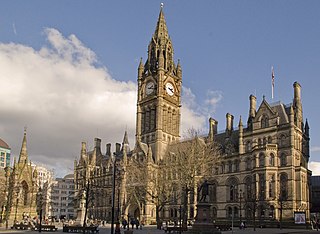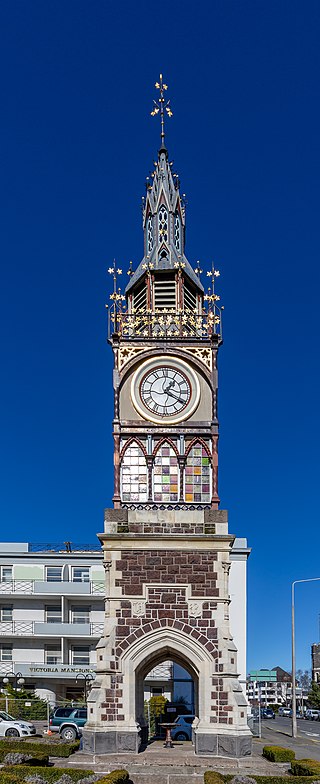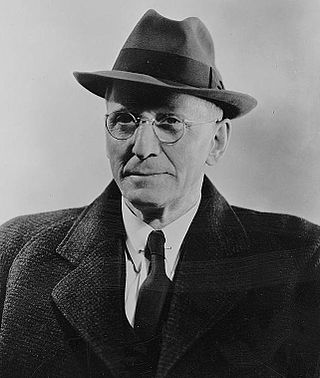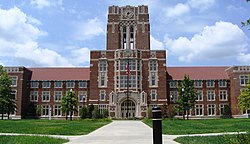
Manchester Town Hall is a Victorian, Neo-gothic municipal building in Manchester, England. It is the ceremonial headquarters of Manchester City Council and houses a number of local government departments. The building faces Albert Square to the north and St Peter's Square to the south, with Manchester Cenotaph facing its southern entrance.

The Tennessee Theatre is a movie palace in the downtown core of Knoxville, Tennessee, United States. The theater was built in 1928 in the 1908 Burwell Building, considered Knoxville's first skyscraper. The theater and Burwell Building were added to the National Register of Historic Places in 1982, and the theater was extensively restored in the early 2000s. The Tennessee Theatre currently focuses on hosting performing arts events and classic films, and is home to the Knoxville Opera and the Knoxville Symphony Orchestra. The theater is managed by AC Entertainment.

King Street Station is a train station in Seattle, Washington, United States. It is served by Amtrak's Cascades, Coast Starlight, and Empire Builder, as well as Sounder commuter trains run by Sound Transit. The station also anchors a major transit hub, which includes Link light rail at International District/Chinatown station and Seattle Streetcar service. It is located at the south end of Downtown Seattle in the Pioneer Square neighborhood, near the intersection of South Jackson Street and 4th Avenue South, and has four major entrances. It is the 15th-busiest station on the Amtrak system, serving as the hub for the Pacific Northwest region.

Minneapolis City Hall and Hennepin County Courthouse, designed by Long and Kees in 1888, is the main building used by the city government of Minneapolis, as well as by Hennepin County, in the U.S. state of Minnesota. The structure has served as mainly local government offices since it was built, and today the building is 60 percent occupied by the city and 40 percent occupied by the County. The building is jointly owned by the city and county and managed by the Municipal Building Commission. The Commission consists of the chair of the County Board, the mayor of the City of Minneapolis, a member of the County Board and a member of the Minneapolis City Council. The County Board chair serves as the president of the Commission and the mayor serves as the vice president. The building bears a striking resemblance to the city hall buildings in Cincinnati and Toronto. The City Hall and Courthouse was added to the National Register of Historic Places in 1974.

The Old City Hall is a Romanesque-style civic building and former court house in Toronto, Ontario, Canada. It was the home of the Toronto City Council from 1899 to 1966 and a provincial court house until 2023, and remains one of the city's most prominent structures.

The University of Tennessee System is a system of public universities in the U.S. state of Tennessee. It is one of two public university systems, the other being the Tennessee Board of Regents (TBR). It consists of four primary campuses in Knoxville, Chattanooga, Pulaski and Martin; a health sciences campus in Memphis; a research institute in Tullahoma; and various extensions throughout the state.

Johnson University is a private Christian university headquartered in Kimberlin Heights, Tennessee, with an additional campus in Kissimmee, Florida. Rooted in the tenets of the Restoration Movement, it maintains affiliation with the Christian churches and churches of Christ.

The John C. Hodges Library is the main library of the University of Tennessee. Located at 1015 Volunteer Boulevard, it is one of many libraries the University of Tennessee houses.

Old Main is the oldest building on the University of Arkansas campus in Fayetteville, Arkansas. It is one of the most recognizable symbols of the University, and of higher education in general in Arkansas.
WUOT is a non-commercial, listener-supported, public radio station in Knoxville, Tennessee. It is owned by the University of Tennessee, and it airs a mix of news, classical music and jazz. It is a charter member of National Public Radio (NPR). The studios and offices are on Circle Park Drive in Knoxville.

St. John's Cathedral located at 413 Cumberland Avenue in Knoxville, Tennessee, is the cathedral church of the Episcopal Diocese of East Tennessee.

The Grandmaster's Palace, officially known as The Palace, is a palace in Valletta, Malta. It was built between the 16th and 18th centuries as the palace of the Grand Master of the Order of St. John, who ruled Malta from 1530 to 1798, and was also known as the Magisterial Palace. When the knights were expelled by Napoleonic France, it became the National Palace. During the period of British rule beginning in 1800, it was the Governor's Palace.

The University of Tennessee, Knoxville is a public land-grant research university in Knoxville, Tennessee, United States. Founded in 1794, two years before Tennessee became the 16th state, it is the flagship campus of the University of Tennessee system, with ten undergraduate colleges and eleven graduate colleges. It hosts more than 30,000 students from all 50 states and more than 100 foreign countries. It is classified among "R1: Doctoral Universities – Very high research activity".

The Victoria Clock Tower, also known as the Diamond Jubilee Clock Tower, is a heritage-registered clock tower located in Christchurch, New Zealand. Designed by Benjamin Mountfort, it is registered as a "Historic Place – Category I" by the New Zealand Historic Places Trust.
Charles Ives Barber was an American architect, active primarily in Knoxville, Tennessee, and vicinity, during the first half of the 20th century. He was cofounder of the firm, Barber & McMurry, through which he designed or codesigned buildings such as the Church Street Methodist Episcopal Church, South, the General Building, and the Knoxville YMCA, as well as several campus buildings for the University of Tennessee and numerous elaborate houses in West Knoxville. Several buildings designed by Barber have been listed on the National Register of Historic Places.
Weston Miller Fulton was an American meteorologist, inventor, and entrepreneur, best known for his invention, the "sylphon," a seamless metal bellows used in thermostats, switches, and other temperature-control devices. Fulton also invented an automatic river gauge while working for the U.S. Weather Bureau, and played a primary role in the development of the depth charge during World War I. His company, now called Fulton Bellows after numerous ownership changes, still operates in Knoxville, as part of the United Flexible Group, which acquired it in 2016.

The United States Post Office and Courthouse, commonly called the Knoxville Post Office, is a state building located at 501 Main Street in Knoxville, Tennessee, United States. Constructed in 1934 for use as a post office and federal courthouse, the building contains numerous Art Deco and Moderne elements, and is clad in Tennessee marble. While the building is still used as a branch post office, the court section is now used by the state courts. The building is listed on the National Register of Historic Places for its architecture and political significance.

John Harcourt Alexander Morgan was a Canadian-American entomologist, educator, and agricultural expert, who served as president of the University of Tennessee from 1919 until 1934. In 1933, he was appointed to the inaugural board of the Tennessee Valley Authority, with which he remained until 1948, including three years (1938–1941) as chairman. In both capacities, he promoted a philosophy known as "the common mooring," which stressed a harmonious relationship between man and the environment, and consistently worked to introduce more efficient and less destructive farming techniques in the Tennessee Valley.

Calgary City Hall, is the seat of government for Calgary City Council, located in the city's downtown core of Calgary, Alberta, Canada. The historic building completed in 1911 serves as the offices for Calgary City Council, consisting of the office of the Mayor, fourteen Councillors and municipal Clerk. Calgary City Hall originally housed the municipal council and portions of administration from its completion in 1911 until the construction of the Calgary Municipal Building adjacent to Old City Hall in 1985, which currently houses the offices of 2,000 civic administrators.

Brown Ayres was an American educator and academic administrator. He was the president of the University of Tennessee and the acting president, dean, and physics professor of Tulane University.



















